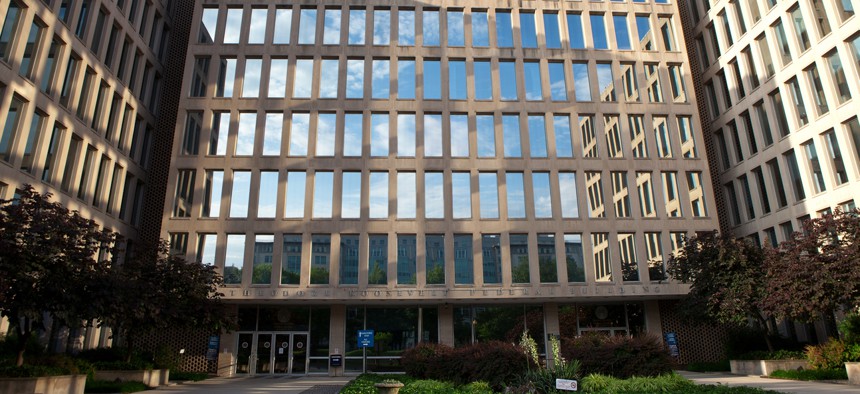
Office of Personnel Management headquarters in Washington. Mark Van Scyoc/Shutterstock.com
OPM Abandons Effort to Make It Easier for Feds to Transfer and Re-Enter Government
The agency had already hit key milestones in its employee digital record project.
The Office of Personnel Management is no longer pursuing electronic personnel records for all federal employees, an initiative the agency had touted as transformative in helping employees more easily move from one agency to another or return to government following retirement or stints in the private sector.
The Trump administration had prioritized the new program as part of the president’s management agenda and it was a “priority goal” for OPM. In the most recent update to that goal, however, OPM said the creation of employee digital records is “not an active project,” noting the agency’s “priorities have shifted from [their] development.” OPM had initially hoped to implement an initial capability for the initiative by Sept. 30, 2019.
The project was intended to make it easier for employees to “transfer between agencies using paperless processing” by providing a “single, comprehensive view of the data of an employee’s federal government career” in a digital format.
“Once implemented, the EDR will provide employees, HR experts, and other authorized users a common language (data standard) so that human capital activity is exchanged seamlessly with the right context,” OPM said in explaining the program. “The EDR will increase the efficiency of human capital activities including: onboarding a new employee, transferring employment between agencies and processing an employee's retirement.”
In the existing system, OPM has said, human capital data systems are siloed and information is difficult to exchange. The agency had already made significant progress in developing the project, releasing alpha and beta versions of the EDR data standards in fiscal 2018. It also set up a data review board and an executive steering committee to keep leadership informed and in-sync with the progress on the digital records. OPM got as far as creating a prototype for exchanging the data in late 2018. Officials interviewed 50 external stakeholders and 16 executives within the agency.
OPM issued a request for information in June 2018 soliciting ideas for the records project and held an “industry day'' to discuss it with possible vendors. The notice laid out a number of key objectives for the project, chief among them allowing for an agency to create a file for federal employees once, that can then be updated as needed completely within the digital environment.
“Currently, human resource data systems lack integration within agencies and interoperability among and between agencies and service providers,” the agency wrote. “This results in redundancy, inefficient and occasionally inaccurate reporting, complex and costly vendor management, and incomplete data that makes it difficult to apply needed business to core HR functions.”
The employee digital record also would have made it easier for agencies to implement changes in legislation, regulation and other policies and procedures, OPM said. The agency hoped to implement the new system “incrementally,” starting with some elements of some employees’ files and eventually expanding to all executive branch employees, retirees and family members and to a variety of HR functions, including recruitment, background investigations, training, performance management and retirement processing.
While the agency is no longer pursuing the project, OPM said the effort was not all for naught. The “foundational activities” that supported its efforts “could accelerate development of an EDR if revived at a future point in time,” OPM said in its recent update. The data review board it created is now focused on implementing the 2018 Foundations for Evidence-Based Policymaking Act. Its efforts have also supported NewPay, an outsourced payroll contract worth $2.5 billion.
OPM did not respond to questions about the end of the project.
Erich Wagner contributed to this report.







